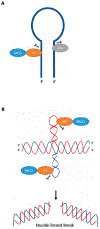Multi-Faceted Roles of ERCC1-XPF Nuclease in Processing Non-B DNA Structures
- PMID: 40766048
- PMCID: PMC12323751
- DOI: 10.3390/dna2040017
Multi-Faceted Roles of ERCC1-XPF Nuclease in Processing Non-B DNA Structures
Abstract
Genetic instability can result from increases in DNA damage and/or alterations in DNA repair proteins and can contribute to disease development. Both exogenous and endogenous sources of DNA damage and/or alterations in DNA structure (e.g., non-B DNA) can impact genome stability. Multiple repair mechanisms exist to counteract DNA damage. One key DNA repair protein complex is ERCC1-XPF, a structure-specific endonuclease that participates in a variety of DNA repair processes. ERCC1-XPF is involved in nucleotide excision repair (NER), repair of DNA interstrand crosslinks (ICLs), and DNA double-strand break (DSB) repair via homologous recombination. In addition, ERCC1-XPF contributes to the processing of various alternative (i.e., non-B) DNA structures. This review will focus on the processing of alternative DNA structures by ERCC1-XPF.
Keywords: DNA repair; ERCC1-XPF; genetic instability; non-B DNA structure.
Conflict of interest statement
Conflicts of Interest: The authors declare no conflict of interest.
Figures







Similar articles
-
ERCC1/XPF Is Important for Repair of DNA Double-Strand Breaks Containing Secondary Structures.iScience. 2019 Jun 28;16:63-78. doi: 10.1016/j.isci.2019.05.017. Epub 2019 May 16. iScience. 2019. PMID: 31153042 Free PMC article.
-
Role of the nucleotide excision repair endonuclease XPF in the kinetoplastid parasite Trypanosoma brucei.Sci Rep. 2025 Jul 2;15(1):23579. doi: 10.1038/s41598-025-08659-y. Sci Rep. 2025. PMID: 40603543 Free PMC article.
-
Small Molecule Antagonists of the DNA Repair ERCC1/XPA Protein-Protein Interaction.ChemMedChem. 2024 Apr 16;19(8):e202300648. doi: 10.1002/cmdc.202300648. Epub 2024 Mar 5. ChemMedChem. 2024. PMID: 38300970 Free PMC article.
-
Function and Interactions of ERCC1-XPF in DNA Damage Response.Molecules. 2018 Dec 5;23(12):3205. doi: 10.3390/molecules23123205. Molecules. 2018. PMID: 30563071 Free PMC article. Review.
-
Multiple roles of the ERCC1-XPF endonuclease in DNA repair and resistance to anticancer drugs.Anticancer Res. 2010 Sep;30(9):3223-32. Anticancer Res. 2010. PMID: 20944091 Review.
References
-
- Bindra RS; Glazer PM Genetic instability and the tumor microenvironment: Towards the concept of microenvironment-induced mutagenesis. Mutat. Res 2005, 569, 75–85. - PubMed
-
- Beckman RA; Loeb LA Genetic instability in cancer: Theory and experiment. Semin. Cancer Biol 2005, 15, 423–435. - PubMed
-
- Breivik J; Gaudernack G Genomic instability, DNA methylation, and natural selection in colorectal carcinogenesis. Semin. Cancer Biol 1999, 9, 245–254. - PubMed
Grants and funding
LinkOut - more resources
Full Text Sources
